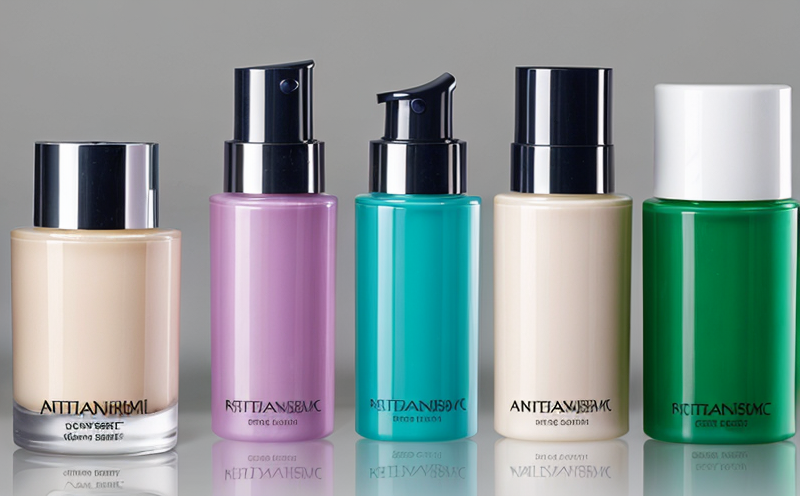Preservative Effectiveness in Emulsion-Based Cosmetics
In today’s competitive cosmetic industry, ensuring product safety and efficacy is paramount. Emulsion-based cosmetics present a unique challenge due to their complex formulation. These products often contain water-in-oil or oil-in-water emulsions that serve as an ideal environment for microbial growth. Therefore, the evaluation of preservative effectiveness in these formulations is critical.
The primary objective of this service involves assessing whether preservatives can effectively inhibit microorganism growth in emulsion-based cosmetic products over a defined period. This service ensures compliance with international standards such as ISO and FDA guidelines. The testing process encompasses several key steps, including formulation preparation, inoculation with relevant test organisms, incubation under controlled conditions, observation of microbial growth, and quantification.
The emulsions used in cosmetics are often highly complex mixtures comprising oils, water, surfactants, and various other ingredients. This complexity makes it challenging to predict how well a given preservative will perform against potential contaminants. Our state-of-the-art laboratory uses advanced analytical techniques like high-performance liquid chromatography (HPLC), Fourier-transform infrared spectroscopy (FTIR), and microbial challenge testing to evaluate the efficacy of preservatives.
For instance, in an emulsion-based product, the presence of multiple phases can affect the distribution of a preservative. This distribution can vary depending on factors such as pH levels, temperature, and the nature of the surfactants used. Understanding these variables is crucial for determining which preservatives perform best under specific conditions.
Our laboratory follows stringent protocols to ensure accurate results. Specimen preparation involves creating a stable emulsion that closely mimics real-world formulations. Inoculation with appropriate test organisms allows us to simulate the actual conditions in which the product might be used or stored. After incubation, any visible growth of microorganisms is recorded and quantified using microbiological methods.
The results from these tests are comprehensive and include detailed reports on preservative performance under various conditions. These reports help our clients make informed decisions about their formulation choices and ensure compliance with regulatory requirements. By providing this service, we not only aid in maintaining product safety but also contribute to the overall quality assurance process within the cosmetic industry.
In summary, evaluating preservative effectiveness in emulsion-based cosmetics is essential for ensuring product stability and preventing contamination. With our expertise and advanced facilities, we offer reliable data that supports regulatory compliance and enhances consumer trust.
Scope and Methodology
The scope of this testing service includes evaluating the preservative efficacy in emulsions used within cosmetic products. This involves assessing whether a chosen preservative can effectively control microbial growth across different environmental conditions that mimic real-world scenarios.
We employ rigorous methodologies to conduct these tests, which typically involve preparing emulsion samples according to industry standards and specifications provided by our clients. These preparations are designed to replicate the exact composition of their products as closely as possible.
Once prepared, the emulsions are inoculated with specific strains of microorganisms known for causing spoilage or deterioration in cosmetics. The choice of organisms depends on the expected usage and storage conditions of the product being tested. For example, Pseudomonas aeruginosa is commonly used to assess preservative activity because it thrives under aerobic conditions.
The samples are then incubated at controlled temperatures (typically ranging from 20°C to 37°C) for varying durations, depending on the type of product and its intended shelf life. During this period, any observable changes in appearance or signs of microbial proliferation are carefully monitored.
Microbiological analysis plays a crucial role in quantifying the extent of growth inhibition by comparing control samples (without preservative) with treated ones. Quantitative methods may include colony-forming unit counts, optical density measurements, and other relevant metrics specified by regulatory bodies like FDA or EU Cosmetics Regulation.
The data collected during these experiments provides valuable insights into how well different preservatives perform under various conditions. This information is essential not only for compliance with regulations but also for optimizing product formulations to meet market demands while ensuring safety and efficacy.
Industry Applications
Preservative effectiveness testing in emulsion-based cosmetics has wide-ranging applications across the cosmetic industry. This service is particularly beneficial for manufacturers who need to comply with stringent hygiene standards set by regulatory authorities worldwide.
For quality managers and compliance officers, ensuring that their products meet these requirements can significantly reduce risks associated with contamination and recalls. By leveraging our testing capabilities, they gain confidence in the reliability of their formulations, thereby protecting both brand reputation and public health.
R&D engineers benefit greatly from this service as well since it allows them to experiment with new preservative systems or reformulate existing products based on empirical evidence rather than guesswork. This approach helps accelerate innovation while minimizing development costs associated with failed experiments.
Procurement teams can also take advantage of our testing services by identifying reliable suppliers whose products consistently demonstrate strong antimicrobial properties when tested against established benchmarks. Such collaboration fosters long-term partnerships built on mutual trust and shared commitment towards quality assurance practices.
In addition to enhancing product safety, this service contributes positively to environmental sustainability efforts within the cosmetic industry. By promoting the use of effective preservatives that minimize waste through spoilage or disposal issues, companies contribute to reducing their ecological footprint.
Why Choose This Test
Selecting the right preservative for emulsion-based cosmetics is a multifaceted decision influenced by numerous factors including product type, target market, expected shelf life, and regulatory requirements. Here are several compelling reasons why choosing this test is advantageous:





